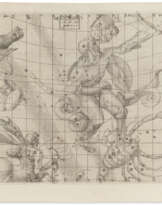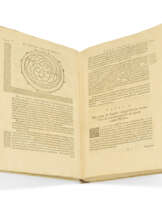ID 1032718
Lot 66 | Tabulae Rudolphinae
Valeur estimée
$ 30 000 – 50 000
Kepler’s last lifetime publication and his crowning achievement, establishing his laws of planetary motion, which were originally based on the orbit of Mars, for all the planets of the solar system and, by implication, beyond—an appealing, unrestored, and large copy with the oversize leaf k3 (illustrating anomalies in the lunar orbit) intact. “For Kepler [his tables were] the substantiation of his laws of planetary motion. He called them ‘my chief astronomical work.’ … The geocentric world view was broken and the heliocentric system, together with Kepler’s laws of planetary motion, triumphed” (Gingerich). This is the work which ensure enduring fame for Kepler and his discoveries.
These tables were based on Tycho Brahe’s observations, supplemented by Kepler’s own, with positions recalculated according to Kepler’s first two laws of planetary orbits. The calculations were a formidable mathematical achievement. Brahe’s data, collected over many years with the help of many assistants, pertained to “perfect” circular orbits, and Kepler had to recalculate everything according to the planets’ true elliptical orbits. “Another innovation completely altered Kepler’s original plan for the form of the tables—'a happy calamity,’ as he called it. In 1617 Kepler first saw John Napier’s epoch-making work on logarithms and was deeply impressed by it, recognizing how this new invention would simplify the time-consuming computations of astronomy” (Gingerich).
This work is bibliographically complex. One thousand copies were printed in Ulm in 1627. There are three states of this printing, affecting only the title-page and the first two gatherings, and largely explained by the publishing history of the book. The title exists in three states; the above is in the third state. The first gathering (dedication to Ferdinand II by Brahe’s heirs and Kepler) is in the third state, and the second gathering (dedicatory poem by Johann Baptiste Hebenstreit) is also in the third state. Brahe had entrusted Kepler to complete his planetary tables, but over the 26 years that it took Kepler to perform this task, the work became his own. Nonetheless, he included a dedication by Brahe’s heirs to the Emperor, as well as one of his own of much greater length. The heirs took exception to this, and so Kepler modified the dedication. Kepler moved from Ulm to Sagan in 1628, and published in Sagan in 1629 the Sportula. The present copy includes the Sportula, which consists of directions for using the tables for astrological purposes.
The fine engraved frontispiece, a superlative example of the genre, was designed by Kepler himself and executed by Georg Celer. It depicts the Temple of Urania inhabited by great astronomers of the past, with Copernicus and Brahe front and center; Kepler himself is in a downstairs room, working. A few copies have additionally a world map which was published posthumously (although the map is dated 1630, all copies known today must have been issued considerably later, certainly after 1658 when the Emperor Leopold to whom the map is dedicated came to the throne). Caspar 79; Houzeau and Lancaster 12754; Lalande p. 190; Norman 1208; Sparrow 116. See Owen Gingerich, “Johannes Kepler and the Rudolphine Tables” in Sky and telescope, 42 (1971), pp 328-33 (reprinted in The Great Copernicus Chase, 1992) for more on the frontispiece and Gingerich, “Johannes Kepler and the New Astronomy,” Quarterly Journal of the Royal Astronomical Society v 13 (1972)
Folio (346 x 230mm). Engraved allegorical frontispiece; numerous woodcut diagrams in text, including full-page of diagrams on k3, an oversize leaf which is often folded in or trimmed but is here unfolded (blank lower margin of final leaf extended, the four leaves of Sportula slightly browned as usual, a few small marginal tears and occasional faint marginal dampstaining). Contemporary red vellum binding (rubbed with pigment loss on boards, spine with some splitting but sound, minor repair to head and tail). Custom box.
| Artiste: | Johannes Kepler (1571 - 1630) |
|---|
| Artiste: | Johannes Kepler (1571 - 1630) |
|---|
| Adresse de l'enchère |
CHRISTIE'S 20 Rockefeller Plaza 10020 New York Etats-Unis | ||||||||||||||
|---|---|---|---|---|---|---|---|---|---|---|---|---|---|---|---|
| Aperçu |
| ||||||||||||||
| Téléphone | +1 212 636 2000 | ||||||||||||||
| Fax | +1 212 636 4930 | ||||||||||||||
| Conditions d'utilisation | Conditions d'utilisation | ||||||||||||||
| transport |
Service postal Service de messagerie ramassage par vous-même | ||||||||||||||
| Modes de paiement |
Virement bancaire | ||||||||||||||
| Heures d'ouverture | Heures d'ouverture
|













